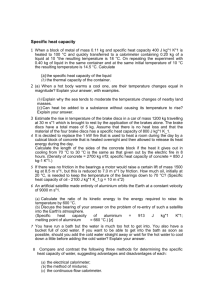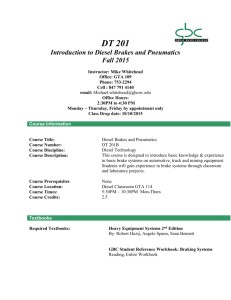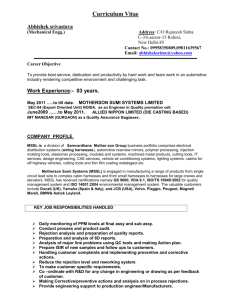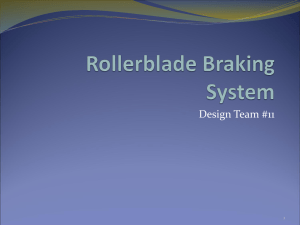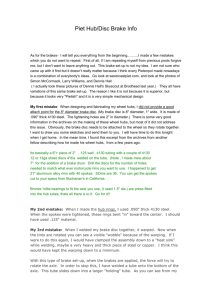MULTIPLE DISC BRAKE (SAE B size)
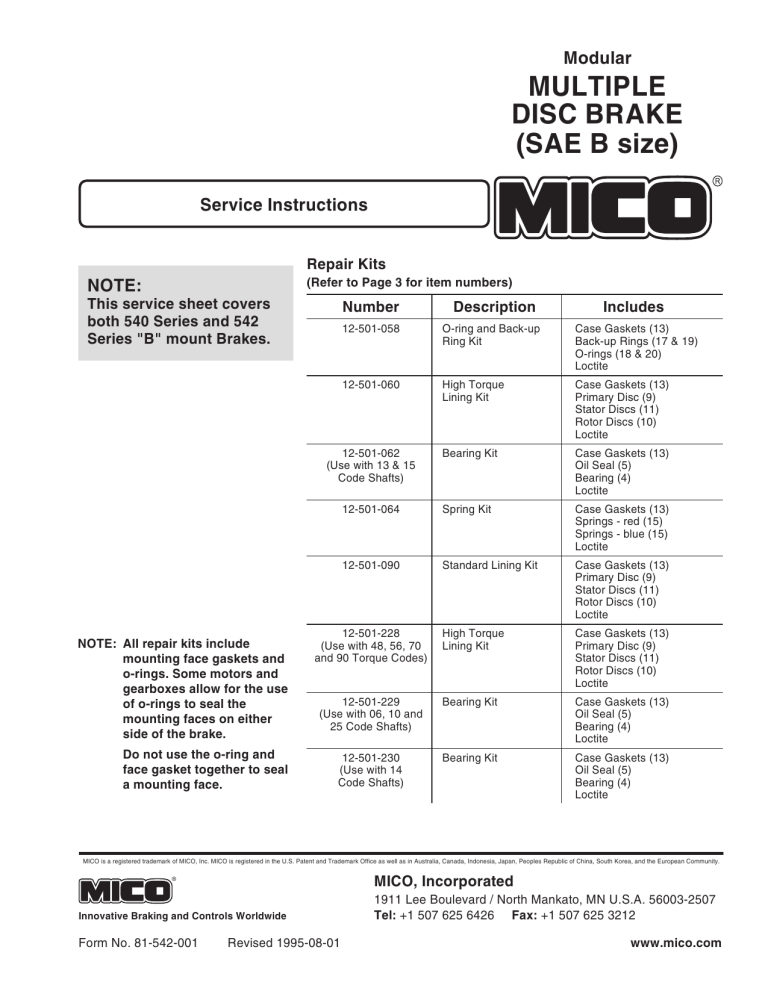
Modular
MULTIPLE
DISC BRAKE
(SAE B size)
Service Instructions
NOTE:
This service sheet covers both 540 Series and 542
Series "B" mount Brakes.
Repair Kits
(Refer to Page 3 for item numbers)
Number
12-501-058
Description
O-ring and Back-up
Ring Kit
12-501-060 High Torque
Lining Kit
12-501-062
(Use with 13 & 15
Code Shafts)
12-501-064
Bearing Kit
Spring Kit
12-501-090 Standard Lining Kit
NOTE: All repair kits include mounting face gaskets and o-rings. Some motors and gearboxes allow for the use of o-rings to seal the mounting faces on either side of the brake.
Do not use the o-ring and face gasket together to seal a mounting face.
12-501-228
(Use with 48, 56, 70 and 90 Torque Codes)
High Torque
Lining Kit
12-501-229
(Use with 06, 10 and
25 Code Shafts)
Bearing Kit
12-501-230
(Use with 14
Code Shafts)
Bearing Kit
Includes
Case Gaskets (13)
Back-up Rings (17 & 19)
O-rings (18 & 20)
Loctite
Case Gaskets (13)
Primary Disc (9)
Stator Discs (11)
Rotor Discs (10)
Loctite
Case Gaskets (13)
Oil Seal (5)
Bearing (4)
Loctite
Case Gaskets (13)
Springs - red (15)
Springs - blue (15)
Loctite
Case Gaskets (13)
Primary Disc (9)
Stator Discs (11)
Rotor Discs (10)
Loctite
Case Gaskets (13)
Primary Disc (9)
Stator Discs (11)
Rotor Discs (10)
Loctite
Case Gaskets (13)
Oil Seal (5)
Bearing (4)
Loctite
Case Gaskets (13)
Oil Seal (5)
Bearing (4)
Loctite
MICO is a registered trademark of MICO, Inc. MICO is registered in the U.S. Patent and Trademark Office as well as in Australia, Canada, Indonesia, Japan, Peoples Republic of China, South Korea, and the European Community.
Innovative Braking and Controls Worldwide
MICO, Incorporated
1911 Lee Boulevard / North Mankato, MN U.S.A. 56003-2507
Tel: +1 507 625 6426 Fax: +1 507 625 3212
Form No. 81-542-001 Revised 1995-08-01 www.mico.com
DISASSEMBLY
1. Remove two socket head assembly bolts (1). A suitable holding fixture is useful to keep brake in position.
2. Tap female end of spline shaft assembly (7) and spring plate (14) with soft mallet to separate cover.
If sections will not separate, use a screwdriver to carefully pry sections apart.
3. Remove retaining ring (3) from spline shaft assembly (7).
4. Remove spline shaft assembly (7) from cover (6) by tapping male end of spline shaft assembly with soft mallet.
5. Remove retaining ring (2) from cover (6) and press out oil seal (5) and bearing (4) if required.
6. Remove four socket head shoulder bolts (8). A suitable holding fixture is useful to hold brake in position.
Do not remove shoulder bolts without pressurization of brake, approximately 20.68 bar (300 PSI) or damage may result.
7. Remove primary disc (9), rotor discs (10) and stator discs (11).
8. Release the pressure to brake before removing the four socket head cap screws (12).
9. Remove spring plate (14).
10. Remove case gasket (13) from spring plate (14).
11. Before removing springs (15), note pattern and color for reassembly purposes.
12. Remove piston (16) by carefully exerting hydraulic pressure through brake release port on pressure plate (21).
13. Remove o-rings (18 & 20) and back-up rings (17 &
19) from piston (16).
NOTE: Be careful not to scratch or mar piston.
14. Remove case gasket (13) from pressure plate (21).
ASSEMBLY
LUBRICATE ALL RUBBER COMPONENTS FROM
REPAIR KIT WITH CLEAN TYPE FLUID USED IN
THE SYSTEM.
1. Clean all parts thoroughly before assembling.
2. Press oil seal (5) into bore until it is flush with bearing shoulder.
DRY DESIGN BRAKE; oil seal (5) must be installed with open side facing pilot end of cover
(6).
LIQUID COOLED BRAKE; oil seal (5) must be installed with closed side facing pilot end of cover
(6). Note direction of seal for Liquid Cooled
Brakes.
3. Press bearing (4) into position until it bottoms out on oil seal borestep.
4. Install retaining ring (2) into cover (6).
5. Press spline shaft assembly (7) into bearing (4) until shaft bottoms on shaft shoulder. Bearing inner race must be supported during this operation.
6. Install retaining ring (3) on spline shaft assembly
(7).
7. Install back-up rings (17 & 19) on piston (16) toward spring pockets.
8. Install o-rings (18 & 20) on piston (16). Be sure o-rings are flat and all twists removed.
NOTE: Be careful not to scratch or mar piston.
9. Lubricate piston (16) with type fluid used in the system. Carefully press piston into pressure plate (21).
Be sure piston is oriented so threaded holes in piston are in alignment with through holes in spring plate (14) when installed.
10. Install springs (15) according to pattern and color noted during disassembly. Different colored springs must be alternated.
11. Affix case gaskets (13) to pressure plate (21) and spring plate (14).
12. Place unit on a press. Using fixture, depress and install four socket head assembly bolts (12).
NOTE:
Apply two drops of Loctite #242 to threads.
Torque bolts 47.5-54.2 N·m (35-40 lb·ft). A suitable holding fixture is useful to hold brake in position.
13. Install stator discs (11) and rotor discs (10). Begin with a rotor disc (10) and alternate with stator discs
(11). For high torque models with four rotors and four stators the last stator should be assembled next to the primary disc (9).
14. Install primary disc (9).
15. Align discs and partially screw in four socket head shoulder bolts (8).
NOTE: Apply two drops of
Loctite #242 to threads.
Inspect for free movement of stack. Pressurize brake release port, approximately 20.68 bar (300 PSI), to release discs.
Torque shoulder bolts 20.3-24.4 N·m (15-18 lb·ft) and release pressure. A suitable holding fixture is useful to hold brake in position.
16. Install cover (6) using socket head assembly bolts
(1).
NOTE: Apply two drops of Loctite #242 to threads.
Torque bolts 12.2-14.9 N·m (9-11 lb·ft).
If hydrostatic bench testing is performed on the brake assembly, release pressure should not exceed 69.0
bar (1000 PSI) unless two additional bolts are used for supplemental clamping.
COOLING OIL RECOMMENDATIONS:
Oil type: Mineral base hydraulic oil such as Mobil DTE 24,
Citgo A/W 32 or equivalent
Flow thru capacity: 3.8 - 26.5 L/min (1.0 - 7.0 GPM)
Maximum case pressure: 1.03 bar (15 PSI)
Sump oil volume: Horizontal: 88.7 mL (3 fl. oz.)
Vertical: Contact MICO, Incorporated
MICO, Inc.
(2) Form No. 81-542-001 Revised 1995-08-01
FIGURE 1
NOTES:
l All Repair Kits contain two types of case gaskets (13).
Be sure to use the correct gaskets for your model:
- 542 Series Brakes use this gasket
- 540 Series Brakes use this gasket
*
540 Series Brakes required two 3/8-16 flat head bolts and o-rings to be torqued to 33.9-40.7 N·m (25-30 lb·ft).
s Some 540 Series Brakes did not include retaining ring (2) and oil seal (5).
n Some 540 Series Brakes required only two 3/8-16 bolts (12).
Form No. 81-542-001 Revised 1995-08-01
FIGURE 2
(3) MICO, Inc.
BLEEDING
1. Install brake in system and connect pressure lines.
2. Bleed pressure release section of brake by pressurizing side
SERVICE DIAGNOSIS
PROBLEM
Brake slips
CAUSE
A. Excessive pressure in hydraulic system inlet port and allowing air to escape from top port. Pressure should not exceed 6.89 bar
(100 PSI) during bleeding.
Brake drags or runs hot
Brake will not release
B. Oil in brake if designed for dry use
C. Disc plates worn
D. Springs broken or have taken a permanent set
A. Low actuation pressure
B. Bearing failure
C. Oil in brake
A. Stuck or clogged valve
B. Bad o-rings
C. Discs frozen
3. Apply sufficient pressure to release brake and check for proper operation in system.
EXPLANATION
If there is back pressure in the actuation line of the brake, holding torque will be reduced.
ACTION
Check filters, hose size, restrictions in other hydraulic components.
Wet linings generate 67% of the dry torque Replace oil seal in rating. If the brake has oil in it, check the brake. Check motor the type of oil hydraulic or gearbox.
1. Gearbox oil
2. Hydraulic oil seal. Check piston seals. Note: Internal components will need to be inspected, cleaned and replaced as required.
Check disc thickness.
The thickness of the disc stack sets the torque level. A thin stack reduces torque.
Broken or set springs can cause reduced torque - a rare occurrence.
Check release pressure
(See spring replacement).
The brake should be pressurized to minimum of 1.38 bar (20 PSI) over the full release pressure under normal operating conditions. Lower pressures will cause the brake to drag thus generating heat.
If the bearing should fail, a large amount of drag can be generated.
Excess fill of oil in sump condition thru wet brakes can cause the unit to run hot.
Also excessive rpm in sump condition.
Place pressure gauge in bleed port & check pressure with system on.
Replace bearing.
Brakes are designed to come on when system pressure drops below stated release pressure. If pressure cannot get to brake, the brake will not release.
If release piston will not hold pressure, brake will not release.
These brakes are designed for only limited dynamic braking. A severe emergency stop or prolonged reduced release pressure operation may result in this type of damage.
Drain oil and refill as specified for brakes.
Switch to flow thru cooling.
Place pressure gauge in bleed port - check for adequate pressure.
Replace defective line or component.
Replace o-rings.
Replace disc stack.
MICO could not possibly know of and give advice with respect to all conceivable applications in which this product may be used and the possible hazards and/or results of each application. MICO has not undertaken any such wide evaluation. Therefore, anyone who uses an application which is not recommended by the manufacturer, first must completely satisfy himself that a danger will not be created by the application selected, or by the particular model of our product that is selected for the application.
MICO has made every attempt to present accurate information in catalogs, brochures and other printed material. MICO can accept no responsibility for errors from unintentional oversights that may exist. Due to a continuous program of product improvement, materials, specifications, and product documentation are subject to change without notice or obligation.
MICO, Inc.
(4) Form No. 81-542-001 Revised 1995-08-01

